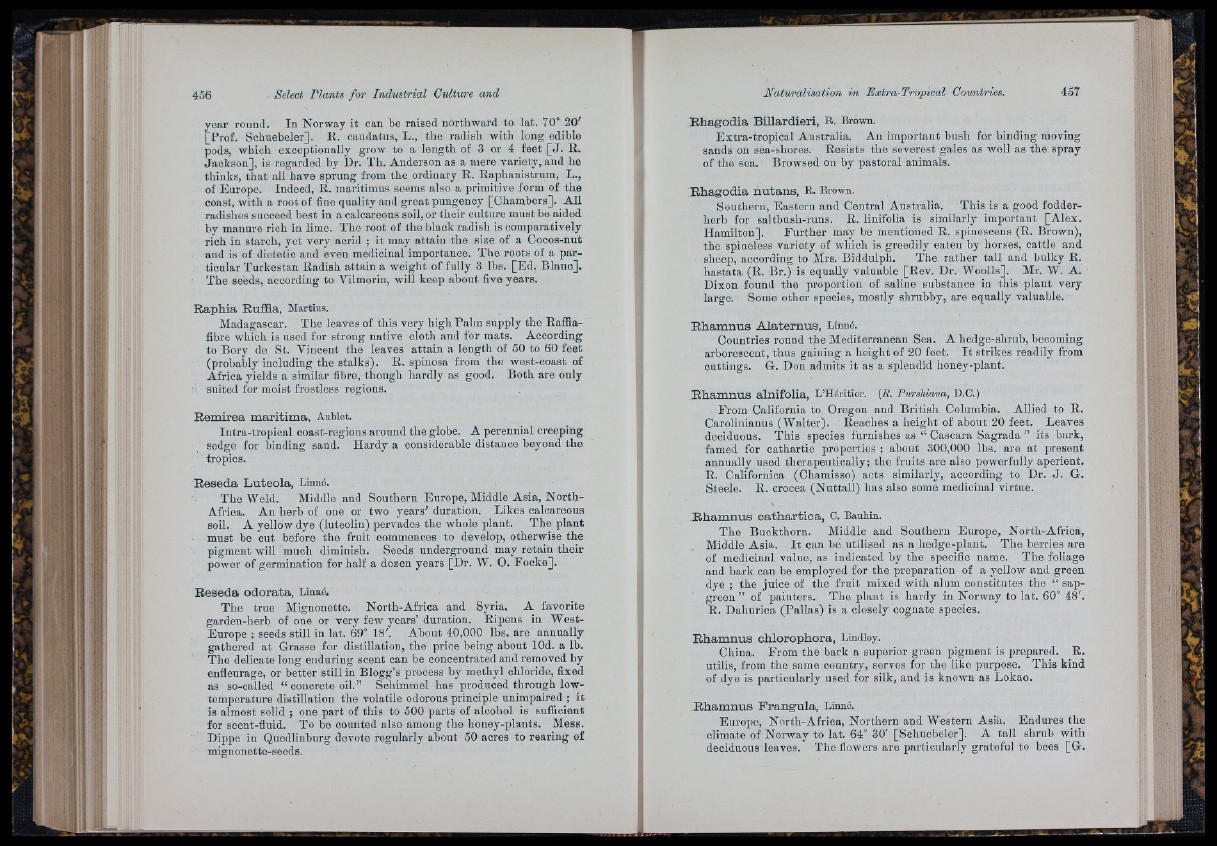
year round. In Norway it can be raised nortbward to lat. 70° 20'
[Prof. Schuebeler]. R. caudatus, L., the radish with long edible
pods, which exceptionally grow to a length of 3 or 4 feet [ J . R.
Jackson], is regarded by Dr. Th. Anderson as a mere variety, and he
thinks, th a t all have sprung from the ordinary R. Raphanistrum, L.,
of Europe. Indeed, R. maritimus seems also a primitive form of the
coast, with a root of fine quality and great pungency [Chambers]. All
radishes succeed best in a calcareous soil, or their cnlture must be aided
by manure rich in lime. The root of the black radish is comparatively
rich in starch, yet very acrid ; it may attain the size of a Coeos-nut
and is of dietetic and even medicinal importance. Tlie roots of a particular
Turkestan Radish attain a weight of fully 3 lbs. [Ed. Blanc].
The seeds, according to Vilmorin, will keep about five years.
R a p h ia R u ffla , Martius.
Madagascar. The leaves of this very high Palm supply the Raffia-
fibre which is used for strong native cloth and for mats. Aecording
to Bory de St. Vincent the leaves attain a length of 50 to 60 feet
(probably including the stalks). R. spinosa from the west-coast of
Africa yields a similar fibre, though hardly as good. Both are only
suited for moist frostless regions.
R em i r e a m a r i t im a , Aublet.
Intra-tropical coast-regions around the globe. A perennial creeping
sedge for binding sand. Hardy a considerable distance beyond the
tropics.
R e s e d a L u te o l a , Linné.
The Weld. Middle and Southern Europe, Middle Asia, North-
Africa. An herb of one or two years’ duration. Likes calcareous
soil. A yellow dye (luteolin) pervades the whole plant. The plant
must be cut before the fruit commences to develop, otherwise the
pigment will much diminish. Seeds underground may retain th eir
power of germination for half a dozen years [Dr. W. O. Focke].
R e s e d a o d o r a ta , Linné.
The true Mignonette. North-Africa and Syria. A favorite
garden-herb of one or very few years’ duration. Ripens in West-
Europe ; seeds still in lat. 69° 18'. About 40,000 lbs. are annually
gathered a t Grasse for distillation, the price being about lOd. a lb.
The delicate long enduring scent can he concentrated and removed by
enfleurage, or better still in Blogg’s process by methyl chloride, fixed
as so-called “ concrete oil.” Schimmel has produced through low-
temperature distillation the volatile odorous principle unimpaired ; it
is almost solid ; one part of this to 500 parts of alcohol is sufficient
for scent-fluid. To be counted also among tbe honey-plants. Mess.
Dippe in Quedlinburg devote regularly about 50 acres to rearing of
mignonetto-seeds.
R h a g o d ia B iU a rd ie ri, R. Brown.
Extra-tropical Australia. An important hush for binding moving
sands on sea-shores. Resists the severest gales as well as the spray
of the sea. Browsed on by pastoral animals.
R h a g o d ia n u t a n s , R. Brown.
Southern, Eastern and Central Australia. This is a good fodder-
herb for saltbush-runs. E. linifolia is similarly important [Alex.
Hamilton]. Further may be mentioned R. spineseens (R. Brown),
the spineless variety of which is greedily eaten by horses, cattle and
sheep, according to Mrs. Biddulph. The rather tall and bulky E.
hastata (R. Br.) is equally valuable [Rev. Dr. Woolls_. Mr. W. A.
Dixon found the proportion of saline substance in this plant very
large. Some other species, mostly shrubby, are equally valuable.
R h a m n u s A l a t e r n u s , Linné.
Countries round the Mediterranean Sea. A hedge-shrub, becoming
arborescent, thus gaining a height of 20 feet. I t strikes readily from
cuttings. G. Don admits it as a splendid honey-plant.
_RhamnUS a ln ifo lia , L’Héritier. {R. PursUana, D.C.)
From California to Oregon and British Columbia. Allied to R.
Caroliuianus (Walter). Reaches a height of about 20 feet. Leaves
deciduous. This species furnishes as “ Casoara Sagrada ” its bark,
famed for cathartic properties ; about 300,000 lbs. are a t present
annually used therapeutically; the fruits are also powerfully aperient.
R. Californica (Chamisso) acts similarly, according to Dr. J . G.
Steele. R. crooea (Nuttall) has also some medicinal virtue.
R h a m n u s e a t h a r t i o a , C. Bauhin.
The Buckthorn. Middle and Southern Europe, North-Africa,
Middle Asia. I t can be utilised as a hedge-plant. The berries are
of medicinal value, as indicated by the specific name. The foliage
and bark can be employed for the preparation of a yellow and green
dye ; the juice of the fruit mixed with alum constitutes the “ sap-
green ” of painters. The plant is hardy in Norway to lat. 60° 48'.
R. Dahurica (Pallas) is a closely connate species.
R h a m n u s e h lo r o p h o r a , Lindley.
China. From the bark a superior green pigment is prepared. B.
utilis, from the same country, serves for the like purpose. This kind
of dye is particularly used for silk, aud is known as Lokao.
R h a m n u s F r á n g u l a , Linné.
Europe, North-Africa, Northern and Western Asia. Endures the
climate of Norway to lat. 64° 30' [Schnebeler], A tall shrub with
deciduous leaves. The flowers are particularly grateful to bees [G.